There’s sometimes an audible gasp from the class after singing REDEEMING GRACE (page 218t), THE HUMBLE PENITENT (399), or Allison Blake Steel’s arrangement of HICKS’ FAREWELL (403). Why the surprise? A lifetime of listening and performing music conditions us to expect that a song will end on its tonic chord—the chord that functions as a “home” for that song’s major or minor key. In 218t, 399, and 403, the bass ends on the expected tonic (1-fa in major or 1-la in minor), but a note sung by some other part creates a chord other than the home chord. We are left with an unanswered expectation of return.
I don’t have polished recordings of these songs, but here’s somewhere to start. Scores for the songs are later in the post.
PLAY ShH 218t Redeeming Grace
PLAY ShH 399 The Humble Penitent
PLAY ShH 403 Hicks’ Farewell
A little music theory: the tonic triad is created from the first, third, and fifth degrees of the scale—typically, the notes sounded by the keyer. In major, the tonic triad is 1-fa, 3-la, and 5-sol, while in minor the tonic triad is 1-la, 3-fa, and 5-la. When the bass sings the first degree of the scale, a tonic triad is in root position. Many, many shape note songs don’t end with a tonic triad, however. Most minor songs end with just the first and fifth degrees of the scale. And not every major song ends with a complete major triad. So I’ll refer to the “home chord” as the chord with the bass on 1 and the other voices on 1, 3, or 5, though not all three notes need be represented. The home chord is the most stable harmony that we expect to hear.
With the exception of 218t, 399, and 403, all the songs in The Shenandoah Harmony end on their home chord, as do all of the songs in The Sacred Harp. (A few songs shift into another key entirely, or modulate, as in ADMIRATION on page 160, but these also end in the home chord of their new key.) In contrast, REDEEMING GRACE and THE HUMBLE PENITENT, both “major,” end on 1-fa and 6-la, with the bass on 1, while HICKS’ FAREWELL (“minor”) ends on 1-la and 4-sol, with the bass choosing between those two. The final chord is neither the tonic chord nor any chord in root position. Since a sequence of harmonies that ends a musical phrase is called a cadence, I’ve dubbed this ending an unanswered cadence. Of course, every shape-note song repeats at least once, because we sing both shapes and words, with more repeats if more verses are sung. So the unanswered cadence is “answered” by a return to the beginning of the piece.
FEATURE, OR BUG?
Does the unanswered cadence even properly exist? Early shape note books were plagued by typographical errors. A very common mistake is to have a shape incorrectly placed on the staff. Judging by subsequent printings and purely musical clues, the shape is more likely to be correct than its placement. It’s possible that the 6-la in REDEEMING GRACE and other songs was originally intended to be a 3-la, which would be a member of the home chord. It’s also possible that a 5-sol is intended, rather than a 6-la. As I mention below, there’s at least one shape-note song where I think the final chord contains an error, rather than an intentional unanswered cadence. In addition, unanswered cadences were sometimes edited out of later arrangements. However, as a lover of the “unreformed” shape-note style, I don’t find the actions of late nineteenth century reformers particularly significant.
The best argument for the existence of unanswered cadence is the fact that REDEEMING GRACE retains its final unanswered chord in some books throughout its 200-year publication history, even while other notes in the song were changed. However, as far as I know, it’s the only such song that has an unbroken singing tradition to the present day (through The Christian Harmony and The Southern Harmony). I’ll start with versions of REDEEMING GRACE, then look at other songs that have unanswered cadences and speculate on how the unanswered cadence contributes to our understanding of shape-note music.
EARLY VERSIONS OF REDEEMING GRACE.
REDEEMING GRACE appears in The Southern Harmony, The Christian Harmony, Harmonia Sacra, The Hesperian Harp, and elsewhere. The earliest printed version comes from Wyeth’s Repository, Part Second (1813), page 79. The chooser notes in the tenor on the first phrase of the melody are unique to Wyeth’s.
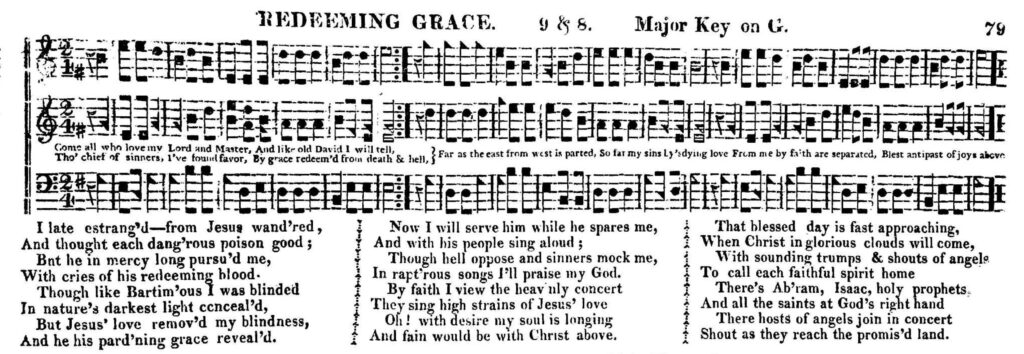
Here’s the arrangement in our book, which matches The Southern Harmony, page 56 (1835), except that we have added the alto from The Hesperian Harp.
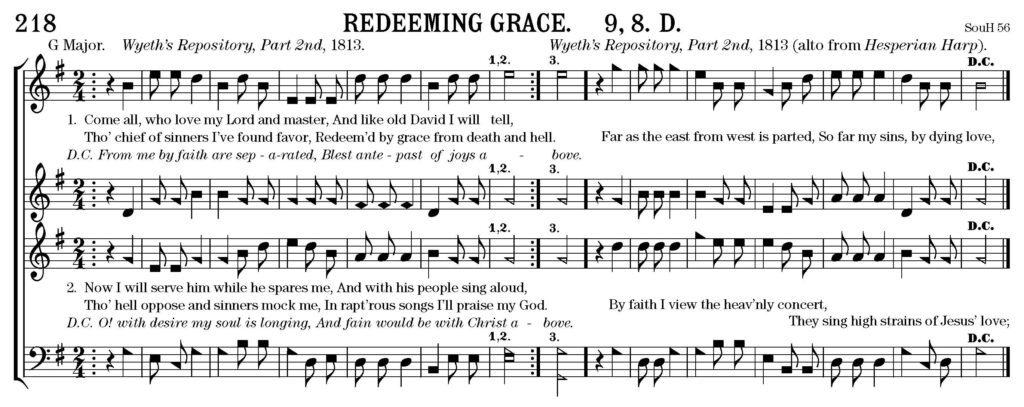
Here’s The Hesperian Harp, page 262 (1848), which is the most mysterious arrangement of all.
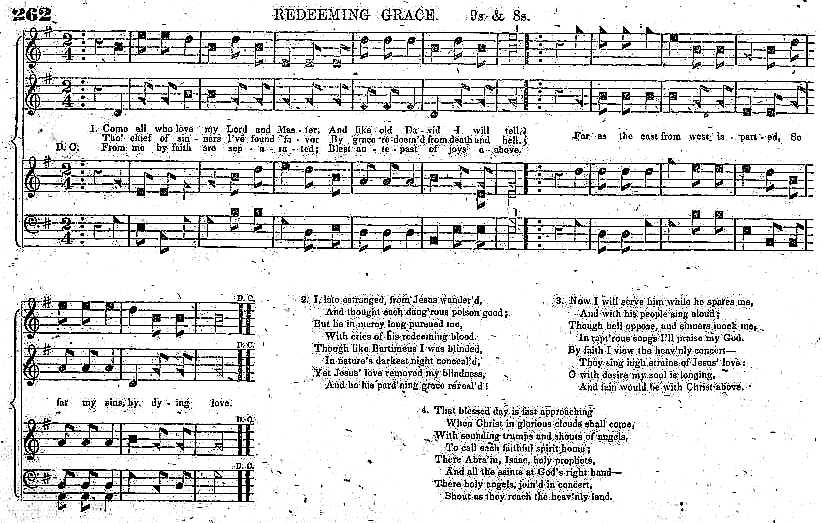
The things to notice in all of these arrangements are the cadences—the endings of the first two phrases and the endings of the piece. The Hesperian Harp presents the class with an array of choices for the chord that ends the A part (this is an AABA song with a D.C. repeat, so this chord ends three of the four phrases in the tune, including the final phrase). If at least one bass singer chooses the 6-la for the final note, the piece ends on a complete minor triad, and, following the “rule” that the key is the final note in the bass, the song is in E minor—that is, 6-la in major becomes 1-la in minor. However, it’s unusual to end with the tenor on the third degree of the minor scale—I can’t think of another song that ends this way. If all the basses choose 1-fa and some of the trebles or tenors choose 6-la, we have an unanswered cadence. If all the basses and tenors choose 1-fa and all the trebles choose 3-la, however, the song ends on the home chord of G major. Note that The Hesperian Harp is the only source to give the class a choice on the final chord.
What are we to make of the choosing notes in these three versions? The rudiments of The Southern Harmony (1835) and The Hesperian Harp (1848) instruct us that if there is more than one singer, both notes may be sung, and this practice is followed by modern day singers. I’m not sure that we should extrapolate backwards in time to Wyeth’s (1813), which does not mention choosing notes. The tenor is supposed to be “the” melody. Is the melody, in fact, a matter of choice? It’s likely that the song was in oral tradition before 1813. Could there have been some disagreement among singers about the notes in the melody? The two choices may even represent first and second endings for the repeated phrase at the beginning of the song; the class could sing the 6-la on the first pass and the 1-fa on the second, or vice versa.
THE REFORMERS.
As I have mentioned elsewhere in this blog, the late 1800s saw a shift towards a more conventional harmonic and rhythmic style (that is, the style of European-influenced common practice music) and the use of seven-shape or round-note notation. In addition, minor sonorities, often conflated with four-shape notation, fell out of favor and triadic harmony was preferred to dyadic harmony (a dyad is a chord with only two different notes; some dyads are ambiguous in that they belong to more than one triad). Although REDEEMING GRACE still has the unanswered cadence in Walker’s The Christian Harmony (1866), page 329, his alto lingers on the 3-la (mi in seven shapes), which completes a minor triad at the A-phrase endings (thanks to Calum Woods for pointing this out). Others have “reformed” the song radically. Here is Hauser’s re-arrangement of REDEEMING GRACE on page 362 of The Olive Leaf (1878). Again, pay attention to the cadences… NOTE: the malformed shapes on F# in the second system, bass, are clearly typos. G (do in 7 shapes) is intended.

The unanswered cadence and indeterminacy of the choosing notes are gone, as is every single minor chord in the piece. Whereas earlier versions had numerous dyads and a few dissonant chords, the chording here is 100% triadic. Hauser liberally uses 4-fa in the bass to substitute major IV chords for minor vi chords and ends squarely on the home chord of G major.
The Harmonia Sacra is a book that had extensive revision with the adoption of seven shapes in the late nineteenth century. Here’s the arrangement from page 242 (image used by permission of harmoniasacra.org):
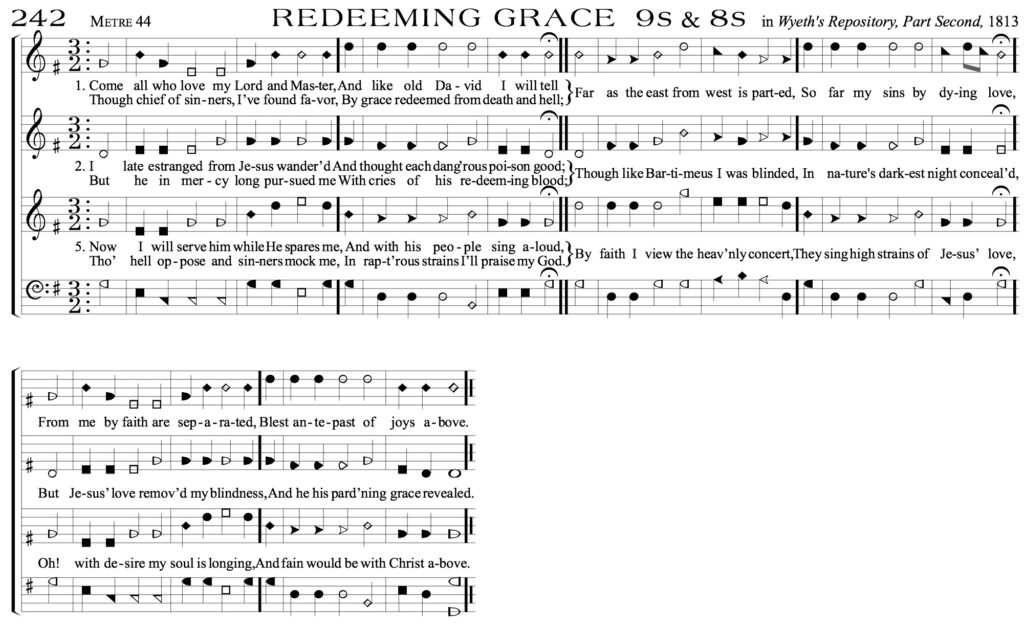
I feel slightly disloyal to the Shenandoah writing this, but this is my favorite arrangement of the song—thanks to Dan Hunter for pointing it out. Although the unanswered cadence is gone, the arranger (who?) preserves many of the minor chords, and adds an exquisite vi6 chord—a triadic completion of the dyad that ends the piece in the earlier four-shape arrangements—at the end of the B part. The use of IV chords creates a more modern sound, but the vi chords hark back to the old four-shape arrangements. NOTE: I’m still following up on the history of Harmonia Sacra revisions and will add more when I know the date for this arrangement.
OTHER FOUR-SHAPE SONGS WITH UNANSWERED CADENCES.
Devotion. The other well known song that sometimes has an unanswered cadence is DEVOTION, as in page 48t of The Sacred Harp. Here’s the first published setting, which comes from Johnson’s Tennessee Harmony (1818) and is reprinted in The Southern Harmony (1835), page 13b. This treble line, ending on the 6-la, is one of the loveliest I know.

Here’s a recording I made of Johnson’s tenor and treble, then one with all three parts, and finally a version with a bass I wrote to emphasize the minor chords. The tenor is in the right channel and the treble is in the left, so you can experiment with hearing just one part at a time.
PLAY Devotion Tenor and Treble
PLAY Devotion all parts
PLAY Devotion bass altered
Johnson “corrected” this arrangement in his second edition (1821), but the 6-la ending in the treble persists in later sources, and also appears in a different arrangement by Davisson in A Supplement to the Kentucky Harmony, ed.2, c.1822; like Johnson, Davisson removes the unanswered cadence in the 1826 edition of SKH.
The Humble Penitent and Conformity. This song too has a history of revision by Davisson and others. Our Shenandoah version is mostly from the third edition of SKH, but borrows one feature from the second edition. Here’s HUMBLE PENITENT, page 13 of SKH ed.2, c.1822.
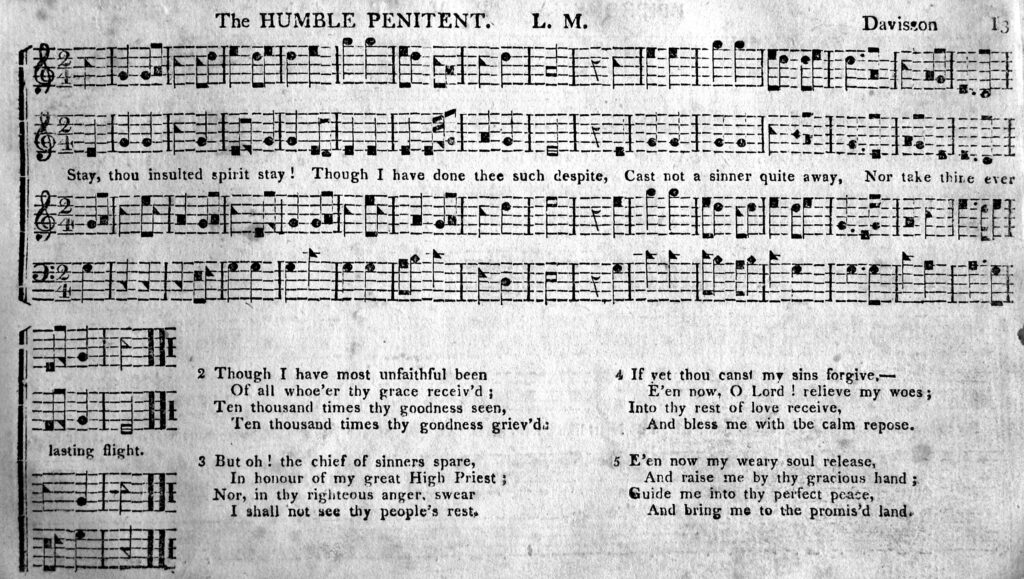
Here’s HUMBLE PENITENT, page 14 of SKH, ed.3, 1826. In the reverse of the normal course of things, the unanswered cadence was added by Davisson a few years later. He also extensively re-arranged the song. I don’t attribute this ending to error; the 6-la appears in two parts and both lines are directed towards it. We changed one note in The Shenandoah Harmony, giving the alto a 6-la in the middle of the piece to create the open 6-3 dyad that’s in the SKH ed.2 version.
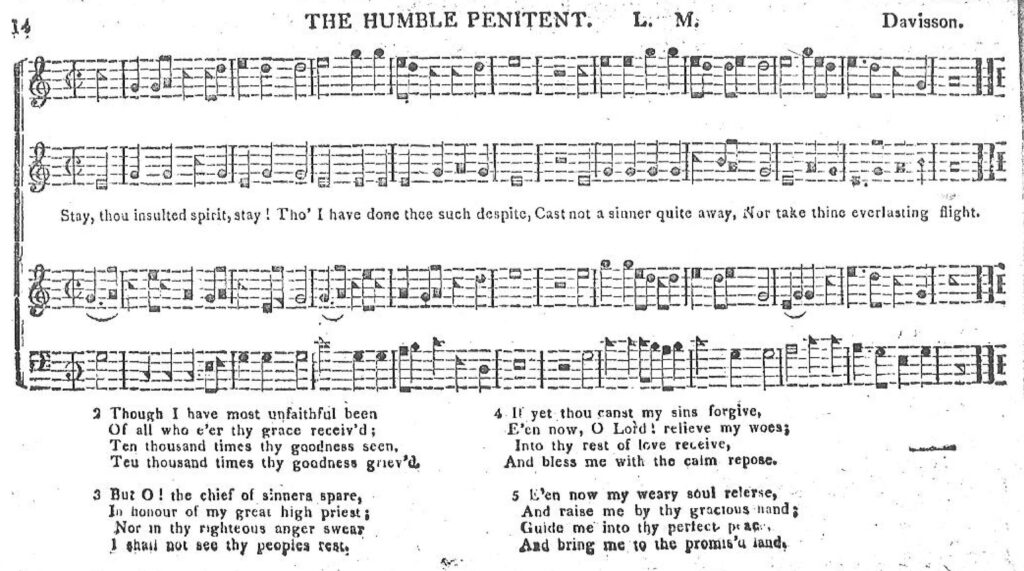
CONFORMITY in the Harmonia Sacra has a similar melody, but different text and arrangement. It does not have an unanswered cadence. Here’s the version in the modern book from harmoniasacra.org; the earliest setting (1832?) lacked an alto and had two bass choosers: a choosing 5-sol above the 1-fa on the first note and a choosing 1-fa below the 6-la on the third note before the end, creating a vi6 triad again!

Friendship (to every willing mind). The version of this song in A Supplement to the Kentucky Harmony has an unanswered cadence created by a 6-la in the alto. The tune is a variant of a melody by Handel; I’ve discussed it extensively HERE. It’s in our book on 221b with a different arrangement. There’s another version in The Christian Harmony. I believe that the unanswered cadence in SKH is a mistake, and Hauser seems to agree—the alto note is changed to a 5-sol in The Hesperian Harp.
Angels Songs. This setting of a British Isles folk tune is part of James P. Carrell’s recently discovered Songs of Zion (1821). The alto 6-la is preserved in The Hesperian Harp (see HERE). As in Friendship, the parallel phrase ends on 5-sol for the alto. I’m somewhat less inclined to see this as a typo, because the song frequently cadences on the vi chord already, and because Hauser doesn’t change it.
Hicks’ Farewell. Allison Blake Steel’s arrangement of HICKS’ FAREWELL, a William Walker melody from The Southern Harmony, ends (in minor) with the bass on a choosing 1-la and the 4-sol above it, while the other voices take 1-la or 4-sol. It’s a delicious chord—reminds me of the second phrase ending in 344t SUFFERING SAVIOR. It is also a great example of how a composer can use old techniques to create something entirely new.
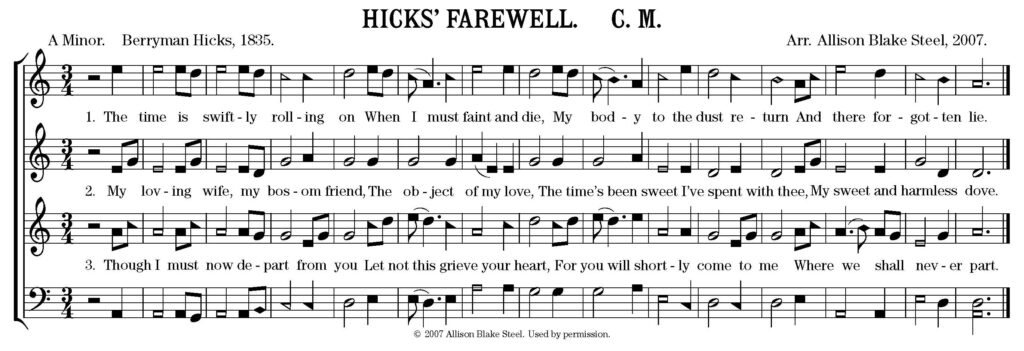
There are additional songs in the late nineteenth century seven-shape repertoire that don’t end on their home chord, but I’ll leave them out, as the musical style had changed considerably by then.
SOME THOUGHTS, AND MORE QUESTIONS.
It seems appropriate to end this post, like these songs, with questions. What does the existence, and persistence, of the unanswered cadence in REDEEMING GRACE tell us? Why did Davisson revise his HUMBLE PENITENT arrangement to add more ambiguity rather than less? How are we to accept that the lovely treble line of DEVOTION ends on the “wrong” note? Of course, we can never know why any of these songs are the way they are, since we have little or no information from the composers and arrangers themselves. However, tunebook compilers of the period felt free to change songs copied from other books, so both the survival of the unanswered cadence in some books and its”correction” in others are telling.
The most obvious hearing is a deliberate confounding of our expectations for the home chord. In common practice music, this kind of fakeout is a type of deceptive cadence. Perhaps this interpretation is too modern, however. I’m not convinced that shape-note composers of this era thought in terms of chord progressions, though in their rudiments the home triad is mentioned as the most stable sonority. I’m inclined to say that we have an ending “destabilization” rather than a chord progression. (Just for kicks, I did some research on “unstable” endings in modern pop music. I couldn’t find information about ending on iv6, but ending on the IV chord is popular enough in contemporary Christian music that one blogger, Greg Howlett, rails against it as a gimmick. Springsteen’s “Lonesome Day” also ends on IV. In fact, some iconoclastic alto could complete the ambiguous 6-1 dyad ending of REDEEMING GRACE, DEVOTION, and HUMBLE PENITENT to a IV64 triad, which has 1-fa in the bass, with the other voices taking 4-fa and 6-la. David Temperley’s “The Cadential IV in Rock” mentions the use of IV to loop back to I, just as our unanswered cadence is followed by a return to the beginning of the music in the next verse. If the unanswered cadence is a “gimmick” of the 1820s, however, it didn’t catch on; as far as I know, no new unanswered cadences were added between 1826 and Steel’s 2007 HICKS’ FAREWELL.)
Alternately, an unanswered cadence may be a way of pointing out a modal ambiguity in the melody itself. Despite the firm differentiation between major and minor in the rudiments of shape-note books, the line between the two is blurred in the songs themselves, and, of course, the distinction had only became important when people started to notate music that had been in the oral tradition. Many shape-note tunes are “modally restless” in that they share phrases with tunes that are in a different mode, and even may belong to tune families that have both “major” and “minor” members. For example, HUMBLE PENITENT has some melodic similarity to BOURBON, which is minor; 2 RHODE ISLAND (minor) and 82 INDIAN PHILOSOPHER (major) are another such pair. John G. McCurry commented in the rudiments of The Social Harp (1855), “There are some tunes that no man can tell whether they are major or minor keyed; e.g. refer to “Minister’s Farewell,” “Rhode Island,” “Antioch,” “Desire for Piety,” that the keys are in conflict all the way through.” Although we don’t know whether modal ambiguity was a well known issue, McCurry, at least, had noticed it. REDEEMING GRACE, HUMBLE PENITENT, DEVOTION, and ANGELS’ SONGS are all major songs that have prominent uses of 6-la, and the ending cadence reinforces the sense of being in major and minor at the same time. In HUMBLE PENITENT, especially, the final cadence says to me “no one knows what key we’re in.”
Another way I hear the unanswered cadence stems from my belief that shape-note music of the early 1800s is primarily melodically, rather than harmonically, driven. Each voice part pursues its own melodic destiny. In the rudiments of The Hesperian Harp, page xviii, Hauser encourages composers to “make each part so good a melody that it will charm even when sung by itself,” although he also stipulates that “[the fifth] should be the last note but one in every bass.” Though the voices are not meant to clash repeatedly, they don’t have to satisfy any particular harmonic expectations (Hauser notes that even the “rule” that the bass should end on 5-1 is sometimes broken). Perhaps the unanswered cadence is nothing more than one part ending in major on 1-fa while another part ends in the relative minor on 1-la. Or perhaps the situation is that, just as a tune that is centered on 1-fa can end on 5-sol, as does HALLELUJAH (SH 146), such a tune can end on 6-la—this is the idea of modal restlessness again—and the same goes for any individual voice part.
Spoiler alert—my next blog post will be on modally restless tunes…
Comments
3 responses to “Questioning the Unanswered Cadence”
Rachel, this is fascinating–I haven’t even read everything or heard all your examples yet; I just hastily skimmed down to your concluding remarks here about “modal restlessness” (great term), after listening once to the end of one example, “Redeeming Grace,” where my subjective experience–upon hearing that sixth in the final chord–was that I didn’t hear it as some kind of slightly jazzy final chord in the major key, but something that instead wants you to hear the melody in the relative minor of that key.
This perhaps built-in tension in shape note music between chordal and melodic emphasis really sounds relevant to me. As an old guitar- and banjo-playing but rather poorly paper-trained folkie, I always thought in chord relationships, and in scale degrees, even if I didn’t know what actual notes I was playing. These days I’m concerned chiefly with playing Irish traditional fiddle (still hearing the implied chords), and now even attempting to compose tunes in that idiom. Of course there’s a lot of dorian and mixolydian there. I’ve always liked tunes that introduced some ambiguity, maybe going merrily along while unexpectedly changing its clothes between minor and major and back. I like tunes that end on the fourth. In writing any kind of music, my ideal is to produce something that, almost simultaneously, comes as a surprise and sounds inevitable.
I’ve always liked the Sacred Harp idea of four simultaneous horizontal melodies, (and of course I’m a lover of polyphony and a Bach freak)–but of course harmonization complicates things–and I guess you’re pointing out that the modal nature of imported tunes complicates them even further. This seems to be what you’re getting into–but I’m afraid I’m getting in way over my head here; I just wanted to give you the superficial first impression of a very unlettered ear musician who’s nevertheless fascinated by what you’ve presented. I’m going to try to look into your contributions further.
Thanks, Ted! I do think our experiences playing old-time music are relevant here, though we have to be careful not to extrapolate back to a time and place where chordal instruments (guitars, pianos, even banjos) were not readily available. A lot of old-time tunes have a similar sense of not settling on a key, and plenty don’t end on the tonic even if the key is fairly well established. Among those who’ve commented on my post here and fasola-discussions, the consensus seems to be that folks like my final suggestion best – that the ending is a byproduct of simultaneous melodic motion, plus a general blurring between major and minor.
Great post! Perhaps it’s worth noting the typo in the Wyeth’s version, where the bottom chooser note of the second beat of the sixth measure in the tenors is printed as fa on F# — especially as it’s only two notes away from the unanswered cadence in question. More generally, I wonder if there’s a third possible narrative here, which is that at least some unanswered cadences began as typos or mistakes but people liked them so they stuck. I know my own writing (musical and verbal) is full of happy accidents — things I write thinking I’m writing something else but which, when I read back, I like better than what I had originally meant to write. Perhaps I’m getting a bit philosophical here, but might we see elements of the material, non-human world (i.e. that of the material text) as part of what “writes” a piece of music? Personally, I love thinking about the vagaries of typesetting and so forth playing a role, alongside whatever we call the composer’s “intention,” in the production of these songs — sort of along the lines of Bruno Latour’s actor-network theory, which attempts to account for human and non-human agency in the production of texts.